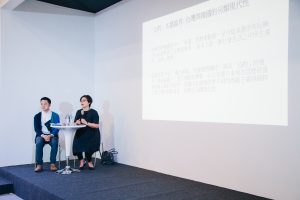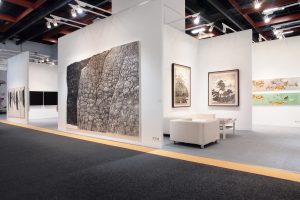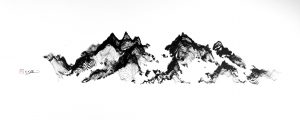By SHOINMACHI5
Editor's Note: This article, "Media or Tradition: Starting from Recent Curatorial and Discourse on 'The End of Ink Painting,'" was written by Shoinmachi5, a contributor to the "Art History Notes from Shoinmachi5." The article is divided into two parts. The first part of the article explored the phenomenon of contemporary artists' ink paintings in academia and exhibitions, starting from the debate on "Is ink painting coming to an end." The second part of the article explores further the question of whether ink painting is marginalized by Taiwan-centric cultural policies due to its Chinese cultural roots. It provides examples from public exhibitions and ART TAIPEI to support this exploration.

In 2017, ART TAIPEI hosted a salon lecture on "The Diversity of East Asian Ink Paintings
In 2021, amid the global COVID-19 pandemic, Hsiung Shih Art Monthly held a conference titled "Has Ink Painting Ended? " The conference, hosted by art historians, painters, gallery owners, and museum directors, delved into a pre-established proposition framework, that is, whether ink painting is facing decline and marginalization in the contemporary era.
However, in recent years, ink art has remained a popular topic in seminars and gallery exhibitions. Taking ART TAIPEI as an example, ink as a medium continues to attract the attention of both domestic and international galleries, which are willing to feature it (you can consider this as a personal observation). In 2017, ART TAIPEI hosted a salon lecture titled "The Diversity of East Asian Ink Paintings," in which art historian Moon Chung-hee and Ink Asia Director Calvin Hui fervently explored the historical context and contemporary ecology of ink paintings (as a medium and its cultural implications) in the three East Asian regions. Whether it may be tempting to view these discussions as a means to sensationalize 'the end of ink painting' to generate attention, it seems to suggest that ink painting has not completely disappeared, nor is it gradually fading into a corner of society.

A view of Red Gold Fine Art in ART TAIPEI 2017 (photo courtesy of Red Gold Fine Art)
So, what are the perspectives of those who believe that ink painting is being marginalized?" In the conference proceedings of "Has Ink Painting Ended??" (Published in 2023), art historian Shih Shou-Chien, one of the organizers of the conference, made the following observation in the preface: "There has been a decline in the number of students majoring in ink painting in art departments across the country, and a trend of marginalization of ink painting is noticeable in various domestic art museums." As for the reasons behind the "Marginalization of ink painting exhibitions in public art museums," he believes it is related to "the close association of ink painting with Chinese culture (at least in terms of historical origins) and its marginalization due to Taiwan-centric cultural policy."
The marginalization of ink painting in recent years in government-sponsored art curations based on Taiwan-centric cultural policy remains a topic for future discussion. The trends mentioned in the previous observation raise the question of whether young students are no longer interested in ink painting or if this is a shared phenomenon encompassing various two-dimensional painting media, including ink, oil, and watercolor paintings.
Ink Painting as a Peinture
Throughout the twentieth century, ink as a medium shared by East Asian countries was integrated into the category of “Peinture”, along with Western media such as oil painting, watercolor, drawing, and printmaking, as part of the modernization process. Fueled by a sense of cultural crisis, China introduced the concept of " Chinese painting". This move aimed to both preserve its cultural history and contemplate reforms by blending Chinese essence with Western techniques.. Simultaneously, Japan also coined the term "Nihonga" (Japanese painting), excluding what was known as "Nanga," a "traditional" style influenced by literati painting from regions like Ningbo, Hangzhou, and Fujian in China, in order to establish its cultural subjectivity. This process did not entail the rejection of ink as a medium but rather the exclusion of specific traditional styles that employed ink as a vehicle

Seigai Kinoshita, ”Sentient Nature”, 1939. Ink and Color on Silk. Collection of Taipei Fine Art Museum
In other words, in the first half of the twentieth century in Japan and in Taiwan under Japanese rule, the 'medium itself' of ink painting had not yet disappeared. Ink, used with brush and inkstone as tools, remained a writing instrument continuously utilized by the public in Taiwan from the late Qing Dynasty to the early Japanese ruling period. Even after the paradigm shift brought by China after World War II, the use of ink as a medium persisted for quite some time.
Nowadays, as writing instruments, brushes and inkstones have been replaced by pencils, ballpoint pens, and fountain pens. They have evolved from daily-use tools to carriers of specific cultural connotations and tools for personal cultivation. Ink has become a tool encountered only in art classes. However, teachers trained through traditional pedagogical systems in schools still use conventional painting drafts and texture stroke methods to teach ink painting, at least during my time in the 2000s. The detachment from contemporary experiences is perhaps the primary reason contributing to the declining popularity of ink as a medium among young students today. Furthermore, as we can imitate brushwork, watercolor, or even pencil and charcoal strokes using digital drawing software like Procreate, it's possible that in a few more years, even pencils or ballpoint pens will also become "non-daily."
Ink Painting as a Culture
However, in recent years, discussions and curations regarding the end of ink painting often tend to blur the lines between "Ink Painting as a Medium" and "Ink Painting as a Culture" (sometimes referred to as brushwork). The latter encompasses the cultural connotations and artistic training behind the brush, paper, ink, and inkstone, as well as the unique aesthetic evaluation of artwork's profound, subtle, vital, and charming characters distinct from Western standards when ink is used as a medium. While a medium should ideally be neutral, it is expected to carry specific cultural traditions, even if such traditions may be just "reinvented." In response to the confusion between the medium of ink and the culture of brushwork, art critic Chia Chi Jason WANG, in an article critiquing the title of the "Has Ink Painting Ended?" conference, proposed the idea that "The End of Brushwork ≠ the End of Ink Painting" (bolded fonts were added by the author), a perspective with which I largely concur.
As early as the early to mid-20th century, artists in China, Japan, Taiwan, and other regions had begun experimenting with integrating the concept of "brushwork" with various other art mediums. For example, Chen Cheng-Po (1895-1947) infused his understanding of Chinese brushwork into his oil paintings, while Long Chin-San (1892-1995) used composite photography to reconstruct real landscapes into vital and charming ink art spaces. In other words, the creative use of brushwork extended beyond traditional ink media. In contemporary times, the use of cross-media approaches is not a novelty, as seen in events like 'INK NOW' in early 2019, where artist Victor Wong nurtured an artificial intelligence named 'A.I. Gemini' to construct new art forms through learning and computation that both learn from and depart from traditional brushwork conventions.
In this context, from the 20th century to the present, rather than characterizing ink painting as a gradual decline, it would be more accurate to say that ink has transcended its daily usage, experiencing liberation from cultural destiny. It has become a medium that artists can freely employ for personal expression or cultural imagery.


Victor Wong & A.I. Gemini, “Escapism 0003”, 2018. Artificial Intelligence, ink on paper, 46 x 118cm. Courtesy of VICTOR WONG & A.I. GEMINI, 3812 Gallery
